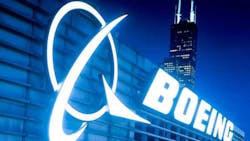The Boeing Company announced a realignment of its R&D division that will result in 800-1,200 research jobs shifting from Washington, and 200-300 from California, to new centers in Alabama, Missouri and South Carolina. The aircraft and aerospace OEM — which is involved in tense negotiations with the International Association of Machinists & Aerospace Workers over a contract extension and future work projects in the Puget Sound area — stated that realigning its Boeing Research & Technology organization continues a “strategy of pursuing future growth and competitiveness while consistently delivering on the company's promises to its customers.”
The goal of the change is to establish individual operations that focus on specific areas of engineering and technology development. The company indicated that the new research centers would be charged with developing technology that has long-term strategic importance for Boeing, up to 30 years into the future, it said.
Earlier this year Boeing outlined a “geographic diversification” of its Information Technology organization, as well as the engineering design centers for the Boeing Commercial Airplanes unit.
The new Boeing Research & Technology research centers will be in Huntsville, Ala.; Southern California; St. Louis; North Charleston, S.C.; and Seattle. The expectation is that each of these centers will operate independently, cooperating with the others and with six more centers worldwide, allowing for more competitiveness and promoting growth opportunities, according to Boeing’s announcement.
"We are reorganizing and realigning our research-and-technology operations to better meet the needs of our Commercial Airplanes and Defense, Space & Security business units, as well as our government R&D customers," stated BR&T vice president and general manager Greg Hyslop.
"Our customers have a common need for new technology that can be integrated quickly and efficiently into current products and production lines, as well as enable new market-leading products and services,” Hyslop continued. “With these changes, we are enhancing our ability to provide effective, efficient and innovative technology solutions."
Each center will pursue specific areas of technical capability and collaborate with university, industry and government research centers.The new Huntsville, Ala., center will focus on Simulation and Decision Analytics, Metals, and Chemical Technology. The Southern California center will be assigned projects in Flight Sciences, Electronics and Networked Systems, and Structures
In St. Louis, the new center will pursue Systems Technology, Digital Aviation and Support Technology, Metallics, and Fabrication Development
At North Charleston, S.C., the focuse will be on Manufacturing Technology, and at Seattle the concentration will be on Manufacturing Technology Integration.
Boeing said the employment totals would grow by 300 to 400 at each of the new centers in Alabama, Missouri and South Carolina. BR&T jobs in Washington are expected to decrease by 800-1,200, and BR&T jobs in California are expected to decrease by 200-300.
About the Author
Robert Brooks
Content Director
Robert Brooks has been a business-to-business reporter, writer, editor, and columnist for more than 20 years, specializing in the primary metal and basic manufacturing industries.
